A Somali Village in Colonial Bradford

This project, led by PI Dr Fozia Bora in collaboration with the Anglo-Somali Society, Cartwright Hall Art Gallery, Everyday Muslim, Bradford City of Culture 2025, the University of Bradford and the Bradford Literature Festival, will uncover the buried history of ‘A Somali Village in Colonial Bradford’. In May-October 1904, the Great Exhibition in Lister Park, inaugurating Cartwright Hall and promoting Bradford's businesses, displayed its star attraction: the Somali Village. 100 Somali individuals lived in a walled compound – 60 men, 20 women and 20 children – attracting 348,550 visitors, the most profitable of the entertainments. This Sapling-funded project will enable the first steps towards Bradford marking the Somali Village to speak to a range of new audiences: the UK Somali community with its critical research questions; the multilingual Bradford community; the public at large who will visit Bradford City of Culture 2025. Via this project, Bradford can build on self-critical responses in German provincial towns, addressing their colonial histories, e.g., the 2005 Oldenburg State Museum’s exhibition, “The Somali Village in Oldenburg 1905 – A Forgotten Colonial History”. We will tell the stories of these ‘Villagers’ – often polyglot cosmopolitans – by centring British Somalis in the public reinterpretation of this history, and enabling the local and contemporary art/culture scene to address issues including the white ethnographic gaze and “looking back” as an act of resistance, crucially avoiding re-display of the Somali community in its internal diversity. This inclusive approach in co-curating with the very community whose ancestors were put on show is ground-breaking, surpassing exhibition practices developed in France, Germany and the UK over 30 years. Somali voices, often absent or deeply obscured in metropolitan and provincial colonial archives, will speak back from the past through recovery of family and oral histories of the carwo (“people of the fair”), and co-create both the research and the cultural outputs.
The project will include workshops on exploring shared goals in research and exhibiting the findings of the research.
Further details will follow in due course.
